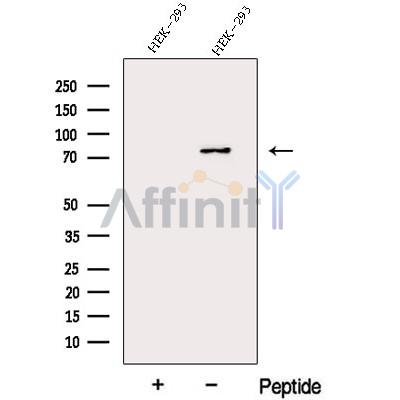DDHD2 Antibody - #DF12932
| Product: | DDHD2 Antibody |
| Catalog: | DF12932 |
| Description: | Rabbit polyclonal antibody to DDHD2 |
| Application: | WB IHC |
| Reactivity: | Human, Mouse, Rat, Monkey |
| Prediction: | Pig, Bovine, Horse, Sheep, Rabbit, Dog |
| Mol.Wt.: | 80 kDa; 81kD(Calculated). |
| Uniprot: | O94830 |
| RRID: | AB_2845893 |
Related Downloads
Protocols
Product Info
*The optimal dilutions should be determined by the end user. For optimal experimental results, antibody reuse is not recommended.
*Tips:
WB: For western blot detection of denatured protein samples. IHC: For immunohistochemical detection of paraffin sections (IHC-p) or frozen sections (IHC-f) of tissue samples. IF/ICC: For immunofluorescence detection of cell samples. ELISA(peptide): For ELISA detection of antigenic peptide.
Cite Format: Affinity Biosciences Cat# DF12932, RRID:AB_2845893.
Immunogens
A synthesized peptide derived from human DDHD2, corresponding to a region within N-terminal amino acids.
- O94830 DDHD2_HUMAN:
- Protein BLAST With
- NCBI/
- ExPASy/
- Uniprot
MSSVQSQQEQLSQSDPSPSPNSCSSFELIDMDAGSLYEPVSPHWFYCKIIDSKETWIPFNSEDSQQLEEAYSSGKGCNGRVVPTDGGRYDVHLGERMRYAVYWDELASEVRRCTWFYKGDKDNKYVPYSESFSQVLEETYMLAVTLDEWKKKLESPNREIIILHNPKLMVHYQPVAGSDDWGSTPTEQGRPRTVKRGVENISVDIHCGEPLQIDHLVFVVHGIGPACDLRFRSIVQCVNDFRSVSLNLLQTHFKKAQENQQIGRVEFLPVNWHSPLHSTGVDVDLQRITLPSINRLRHFTNDTILDVFFYNSPTYCQTIVDTVASEMNRIYTLFLQRNPDFKGGVSIAGHSLGSLILFDILTNQKDSLGDIDSEKDSLNIVMDQGDTPTLEEDLKKLQLSEFFDIFEKEKVDKEALALCTDRDLQEIGIPLGPRKKILNYFSTRKNSMGIKRPAPQPASGANIPKESEFCSSSNTRNGDYLDVGIGQVSVKYPRLIYKPEIFFAFGSPIGMFLTVRGLKRIDPNYRFPTCKGFFNIYHPFDPVAYRIEPMVVPGVEFEPMLIPHHKGRKRMHLELREGLTRMSMDLKNNLLGSLRMAWKSFTRAPYPALQASETPEETEAEPESTSEKPSDVNTEETSVAVKEEVLPINVGMLNGGQRIDYVLQEKPIESFNEYLFALQSHLCYWESEDTVLLVLKEIYQTQGIFLDQPLQ
Predictions
Score>80(red) has high confidence and is suggested to be used for WB detection. *The prediction model is mainly based on the alignment of immunogen sequences, the results are for reference only, not as the basis of quality assurance.
High(score>80) Medium(80>score>50) Low(score<50) No confidence
Research Backgrounds
Phospholipase that hydrolyzes preferentially phosphatidic acid, including 1,2-dioleoyl-sn-phosphatidic acid, and phosphatidylethanolamine. Specifically binds to phosphatidylinositol 3-phosphate (PI(3)P), phosphatidylinositol 4-phosphate (PI(4)P), phosphatidylinositol 5-phosphate (PI(5)P) and possibly phosphatidylinositol 4,5-bisphosphate (PI(4,5)P2). May be involved in the maintenance of the endoplasmic reticulum and/or Golgi structures. May regulate the transport between Golgi apparatus and plasma membrane.
Cytoplasm>Cytosol. Endoplasmic reticulum-Golgi intermediate compartment. Golgi apparatus>cis-Golgi network.
Note: Cycles between the Golgi apparatus and the cytosol. DDHD2 recruitment to the Golgi/endoplasmic reticulum-Golgi intermediate compartment (ERGIC) is regulated by the levels of phosphoinositides, including PI(4)P.
Widely expressed (at protein level).
SAM and DDHD domains together are required for phospholipid binding.
Belongs to the PA-PLA1 family.
Restrictive clause
Affinity Biosciences tests all products strictly. Citations are provided as a resource for additional applications that have not been validated by Affinity Biosciences. Please choose the appropriate format for each application and consult Materials and Methods sections for additional details about the use of any product in these publications.
For Research Use Only.
Not for use in diagnostic or therapeutic procedures. Not for resale. Not for distribution without written consent. Affinity Biosciences will not be held responsible for patent infringement or other violations that may occur with the use of our products. Affinity Biosciences, Affinity Biosciences Logo and all other trademarks are the property of Affinity Biosciences LTD.


